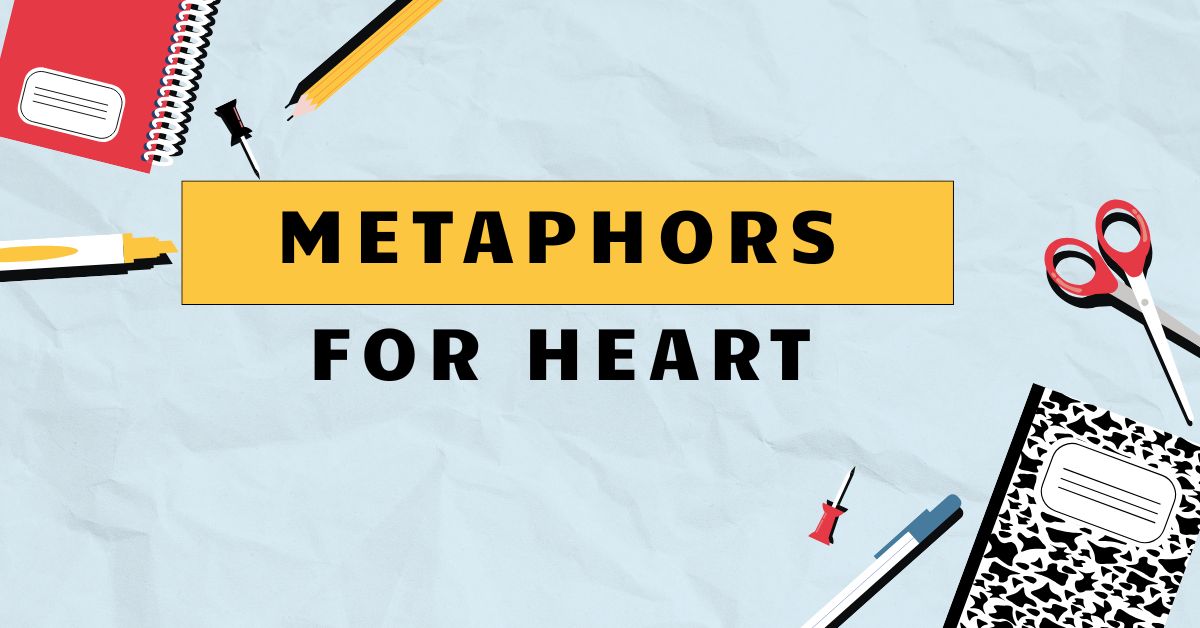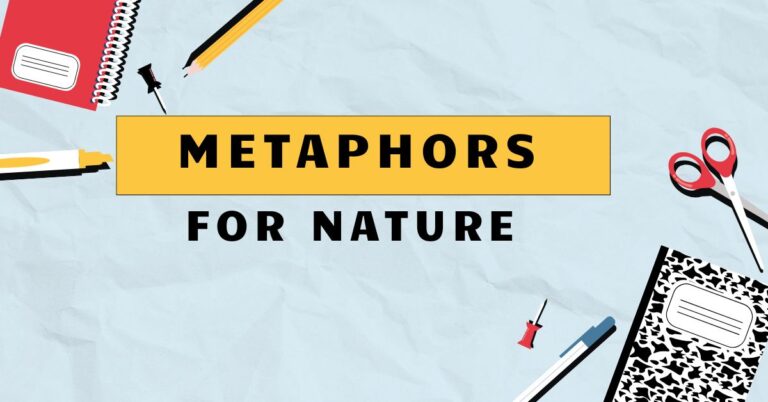50 Heart Metaphors: Exploring Figurative Language in English
Metaphors are powerful tools that enrich our language, adding depth and emotion to our communication. When we speak of the heart, we often venture beyond its literal function as a vital organ, using it as a symbol for emotions, courage, and character.
Understanding these metaphors not only enhances our comprehension of English literature and everyday conversations but also allows us to express ourselves more vividly and poetically. This article delves into the fascinating world of heart metaphors, exploring their various forms, meanings, and applications.
This guide will benefit English language learners, literature enthusiasts, and anyone seeking to expand their expressive capabilities.
By mastering these metaphors, you can unlock a deeper understanding of English and communicate with greater nuance and impact. This article will provide the necessary tools and examples to effectively recognize and use heart metaphors.
Table of Contents
- Introduction
- Definition: What is a Heart Metaphor?
- Structural Breakdown of Heart Metaphors
- Types of Heart Metaphors
- Examples of Heart Metaphors
- Usage Rules for Heart Metaphors
- Common Mistakes with Heart Metaphors
- Practice Exercises
- Advanced Topics in Heart Metaphors
- Frequently Asked Questions
- Conclusion
Definition: What is a Heart Metaphor?
A heart metaphor is a figure of speech where the heart, literally a biological organ responsible for pumping blood, is used symbolically to represent emotions, feelings, character, or courage. It relies on the association of the heart with core human experiences, transcending its physical function to convey deeper, more abstract meanings.
In essence, it’s a comparison between the physical heart and intangible qualities, without using words like “like” or “as,” which would make it a simile.
Metaphors are crucial in language because they allow us to understand abstract concepts through more concrete terms. The heart, being vital for life, naturally becomes a powerful symbol for things we value deeply.
It’s a way of speaking that resonates with emotional truth, even if it’s not literally true.
The function of a heart metaphor is to evoke emotion, create vivid imagery, and add layers of meaning to communication. By using the heart as a metaphor, speakers and writers can express complex feelings in a concise and relatable manner.
This type of figurative language is prevalent in literature, poetry, music, and everyday conversation, making it an essential aspect of English language understanding.
Structural Breakdown of Heart Metaphors
Understanding the structure of heart metaphors involves recognizing the key components that create their symbolic meaning. These components typically include the subject (the quality or emotion being described), the heart (the vehicle or symbol used to represent the subject), and the implied comparison that connects the two.
The basic pattern of a heart metaphor involves attributing characteristics or actions to the heart that are normally associated with emotions or personal qualities. For instance, saying “her heart is cold” doesn’t literally mean her heart’s temperature is low; it means she is emotionally distant or unfeeling.
The relationship between the heart and the subject is one of implicit comparison. The listener or reader must draw the connection between the literal heart and the abstract concept being conveyed.
Consider the following examples to illustrate the structural breakdown:
- “His heart sank.” (Subject: Disappointment; Heart: Symbol of emotion; Implied Comparison: The feeling of disappointment is like a physical sinking sensation in the heart.)
- “She has a heart of gold.” (Subject: Kindness; Heart: Symbol of character; Implied Comparison: Her kindness is as valuable and pure as gold.)
- “He wore his heart on his sleeve.” (Subject: Openness; Heart: Symbol of emotion; Implied Comparison: His emotions are easily visible, as if his heart were exposed.)
The effectiveness of a heart metaphor lies in its ability to create a vivid and immediate understanding of an emotion or characteristic. By understanding the structure, one can better appreciate the nuances and power of this figurative language.
Types of Heart Metaphors
Heart metaphors can be categorized based on the specific emotions, qualities, or characteristics they represent. Here are some common categories:
Heart as the Center of Emotion
This is perhaps the most common type of heart metaphor, where the heart represents the seat of all emotions, including joy, sadness, fear, and anger. It reflects the long-held belief that emotions originate in the heart.
Heart as a Symbol of Love
The heart is frequently used as a symbol of love, affection, and romantic feelings. This association is deeply ingrained in our culture and is often depicted in art, literature, and popular media.
Heart as a Source of Courage
In this context, the heart represents bravery, valor, and the ability to face challenges with determination. It signifies inner strength and resilience.
Heart as a Representation of Character
The heart can also symbolize a person’s moral qualities, such as kindness, compassion, and integrity. A “good heart” implies a virtuous and generous nature.
Heart as the Seat of Compassion
This type of metaphor highlights the heart’s capacity for empathy, understanding, and caring for others. It emphasizes the ability to feel and share the suffering of others.
Examples of Heart Metaphors
To further illustrate the different types of heart metaphors, here are several examples categorized by their primary meaning:
Examples: Heart as Center of Emotion
The following table provides examples of heart metaphors where the heart represents a range of emotions:
| Metaphor | Meaning |
|---|---|
| Her heart fluttered with excitement. | She felt a surge of joyful anticipation. |
| His heart ached with sadness. | He experienced deep sorrow and grief. |
| My heart pounded in my chest. | I felt nervous or afraid. |
| Her heart skipped a beat. | She was surprised or startled. |
| His heart sank when he heard the news. | He felt deeply disappointed. |
| A wave of fear washed over her heart. | She was suddenly overwhelmed by fear. |
| His heart was heavy with grief. | He felt burdened by sadness. |
| Her heart soared with joy. | She felt immense happiness. |
| His heart burned with anger. | He felt intense rage. |
| Her heart was filled with dread. | She felt a strong sense of impending doom. |
| His heart raced with anticipation. | He was eagerly awaiting something. |
| She wore her heart on her sleeve. | She openly expresses her emotions. |
| His heart turned to stone. | He became cold and unfeeling. |
| Her heart was in her mouth. | She was extremely nervous. |
| His heart leaped with joy. | He felt sudden and intense happiness. |
| She poured her heart out to him. | She shared her deepest feelings. |
| His heart bled for the victims. | He felt deep sorrow and sympathy. |
| Her heart trembled with fear. | She was shaking with fear. |
| He followed his heart. | He acted based on his feelings. |
| Her heart cried out in despair. | She felt overwhelming sadness. |
| His heart was touched by her kindness. | He was moved by her generosity. |
| She hardened her heart. | She became emotionally tough. |
| His heart stopped. | He was extremely shocked or frightened (hyperbole). |
Examples: Heart as Symbol of Love
This table illustrates heart metaphors related to love and affection:
| Metaphor | Meaning |
|---|---|
| She gave him her heart. | She offered him her love. |
| He stole her heart. | He won her love. |
| Their hearts were intertwined. | They were deeply in love and connected. |
| She wears his heart on a chain. | She cherishes his love. |
| He poured his heart into the relationship. | He dedicated himself to the relationship with love and effort. |
| Her heart belongs to him. | She is devoted to him. |
| His heart yearned for her. | He deeply desired her love. |
| She captured his heart. | She attracted his love. |
| His heart was full of love for her. | He loved her deeply. |
| She opened her heart to him. | She allowed herself to love him. |
| His heart melted when he saw her. | He felt intense affection for her. |
| Her heart skipped a beat when he smiled. | She felt a rush of love when he smiled. |
| His heart sang when he was with her. | He felt joyful and happy when he was with her. |
| She mended his broken heart. | She helped him heal from a past heartbreak. |
| His heart ached for her presence. | He missed her deeply. |
| She held his heart in her hands. | She had complete control over his love. |
| His heart was hers to keep. | She had his love forever. |
| She guarded her heart carefully. | She was cautious about falling in love. |
| His heart was set on her. | He was determined to win her love. |
| She followed her heart to him. | She let her love guide her to him. |
| Their hearts beat as one. | They were perfectly in sync in their love. |
| He wore his heart out for her. | He exhausted himself trying to win her love. |
| Her heart fluttered at his touch. | She felt a rush of excitement when he touched her. |
Examples: Heart as Source of Courage
The subsequent table provides examples of heart metaphors where the heart signifies courage and bravery:
| Metaphor | Meaning |
|---|---|
| He had the heart of a lion. | He was very brave and courageous. |
| She showed great heart in the face of adversity. | She demonstrated courage during difficult times. |
| He found it in his heart to forgive her. | He summoned the courage to forgive her. |
| She steeled her heart and faced the challenge. | She prepared herself mentally and emotionally for the challenge. |
| He put his heart into the fight. | He fought with all his courage and determination. |
| She has a brave heart. | She is courageous. |
| He lost heart after the defeat. | He became discouraged after the defeat. |
| She took heart from his words. | She gained courage from his words. |
| He kept his heart up despite the setbacks. | He remained courageous despite the setbacks. |
| She followed her heart, even when it was difficult. | She acted with courage, even when it was challenging. |
| He had the heart to tell her the truth. | He was brave enough to tell her the truth. |
| She had no heart for the task. | She lacked the courage to do the task. |
| He hardened his heart to the pain. | He became emotionally tough to endure the pain. |
| She found the heart within herself to persevere. | She discovered inner courage to continue. |
| He faced his fears with a strong heart. | He confronted his fears bravely. |
| She showed true heart in her dedication. | She demonstrated real courage through her commitment. |
| He had a change of heart. | He changed his mind or feelings (often implying a shift towards courage or kindness). |
| She put her whole heart into the project. | She dedicated herself completely and courageously to the project. |
| He lost his heart for adventure. | He no longer had the courage or desire for adventure. |
| She needed to find her heart again. | She needed to rediscover her courage and passion. |
Examples: Heart as Representation of Character
This table includes examples of heart metaphors that represent a person’s character and moral qualities:
| Metaphor | Meaning |
|---|---|
| She has a heart of gold. | She is very kind and generous. |
| He has a good heart. | He is a kind and compassionate person. |
| She has a heart of stone. | She is cold and unfeeling. |
| He has a black heart. | He is evil or malicious. |
| She has a pure heart. | She is innocent and virtuous. |
| He has a generous heart. | He is charitable and giving. |
| She has a warm heart. | She is friendly and affectionate. |
| He has a cold heart. | He is unemotional and distant. |
| She has an open heart. | She is receptive and welcoming. |
| He has a hardened heart. | He has become emotionally tough or cynical. |
| She has a gentle heart. | She is kind and tender. |
| He has a wicked heart. | He is evil and immoral. |
| She has a forgiving heart. | She is willing to forgive others. |
| He has a selfish heart. | He is primarily concerned with his own needs. |
| She has a grateful heart. | She is thankful and appreciative. |
| He has a humble heart. | He is modest and unpretentious. |
| She has a compassionate heart. | She is empathetic and caring. |
| He has a deceitful heart. | He is dishonest and manipulative. |
| She has a loyal heart. | She is faithful and devoted. |
| He has a tender heart. | He is sensitive and caring. |
Examples: Heart as Seat of Compassion
The following table lists examples of heart metaphors highlighting the heart’s role in compassion and empathy:
| Metaphor | Meaning |
|---|---|
| Her heart went out to the refugees. | She felt great sympathy and compassion for the refugees. |
| He has a heart for the less fortunate. | He is compassionate towards those who are disadvantaged. |
| She opened her heart to the suffering of others. | She allowed herself to feel empathy for others’ pain. |
| His heart bled for the victims of the tragedy. | He felt deep sorrow and compassion for the victims. |
| She has a compassionate heart for animals. | She feels empathy for animals and their suffering. |
| His heart ached for the children in need. | He felt profound sadness and compassion for the children. |
| She showed heart by helping the homeless. | She demonstrated compassion by assisting the homeless. |
| He has a heart of mercy. | He is merciful and forgiving. |
| She has a big heart for the needy. | She is very compassionate towards those in need. |
| His heart resonated with their pain. | He felt a deep connection to their suffering. |
| She put her whole heart into helping. | She dedicated herself completely to helping others with compassion. |
| He has a heart for service. | He is dedicated to serving and helping others. |
| She has a tender heart for children. | She feels a deep compassion for children. |
| His heart was moved by their plight. | He was deeply touched by their difficult situation. |
| She has a warm heart for everyone. | She is kind and compassionate towards everyone. |
| He has a heart that understands. | He is empathetic and understanding of others’ feelings. |
| She has a giving heart. | She is generous and giving to those in need. |
| His heart is always open to others. | He is always willing to listen and help others. |
| She has a heart full of kindness. | She is extremely kind and compassionate. |
| He has a heart dedicated to charity. | He is committed to charitable causes. |
Usage Rules for Heart Metaphors
Using heart metaphors effectively requires understanding certain rules and guidelines. While metaphors are inherently figurative, their impact depends on their relevance and clarity.
Context is Key:The meaning of a heart metaphor can vary depending on the context. Ensure that the intended meaning is clear from the surrounding text or conversation.
For example, “His heart was cold” can mean he’s unemotional or unkind, depending on the situation.
Avoid Clichés:Some heart metaphors, like “heart of gold,” are overused and can sound unoriginal. Try to use more creative and less common expressions when possible.
Consider alternatives like “She possesses unparalleled generosity” instead of “She has a heart of gold.”
Consistency is Important: If you start using a particular heart metaphor, maintain consistency in its usage. Mixing metaphors can lead to confusion.
Consider the Audience: Be mindful of your audience when using heart metaphors. Some metaphors may not be universally understood, especially by non-native speakers or those unfamiliar with certain cultural references.
Maintain Emotional Authenticity: Heart metaphors should reflect genuine emotions or qualities. Avoid using them casually or insincerely, as this can diminish their impact.
Use Sparingly: While heart metaphors can be powerful, overusing them can make your language sound melodramatic or insincere. Use them judiciously to emphasize key points or evoke strong emotions.
Common Mistakes with Heart Metaphors
Several common mistakes can occur when using heart metaphors. Recognizing these errors can help you avoid them and use these figures of speech more effectively.
Mixing Metaphors: This occurs when you combine two or more incompatible metaphors, creating a confusing and illogical image.
*Incorrect:* “He climbed the ladder of success with a heart of gold, but the winds of change blew him off course.” (Mixing “climbing the ladder” with “heart of gold” and “winds of change.”)
*Correct:* “He climbed the ladder of success with unwavering determination.”
Literal Interpretation: Taking a heart metaphor literally can lead to misunderstandings. Remember that these are figurative expressions and should not be interpreted in a physical sense.
*Incorrect:* “Her heart is cold, so she needs a blanket.” (Assuming her heart is literally cold.)
*Correct:* “Her heart is cold; she lacks empathy.”
Overuse of Clichés: Using overused heart metaphors can make your writing or speech sound unoriginal and predictable.
*Incorrect:* “He has a heart of gold, and she wears her heart on her sleeve.” (Using two common clichés in one sentence.)
*Correct:* “He is exceptionally generous, and she openly expresses her emotions.”
Misunderstanding Cultural Context: Some heart metaphors have specific cultural connotations that may not be universally understood.
*Incorrect:* Using a metaphor that implies negativity in a culture where it is viewed positively.
*Correct:* Being aware of the cultural implications and choosing appropriate metaphors.
The table below shows the before and after of these common mistakes:
| Mistake | Incorrect Example | Correct Example |
|---|---|---|
| Mixing Metaphors | “He climbed the ladder of success with a heart of gold, but the winds of change blew him off course.” | “He climbed the ladder of success with unwavering determination.” |
| Literal Interpretation | “Her heart is cold, so she needs a blanket.” | “Her heart is cold; she lacks empathy.” |
| Overuse of Clichés | “He has a heart of gold, and she wears her heart on her sleeve.” | “He is exceptionally generous, and she openly expresses her emotions.” |
Practice Exercises
To test your understanding of heart metaphors, complete the following exercises. Identify the meaning of each heart metaphor in the sentences below.
- Her heart fluttered when she saw him.
- He has a heart of stone.
- They poured their hearts into the project.
- His heart sank when he heard the news.
- She wore her heart on her sleeve.
- He found it in his heart to forgive her.
- Her heart went out to the victims.
- His heart was full of joy.
- She hardened her heart to the pain.
- He followed his heart.
Answer Key:
- She felt excited or nervous.
- He is cold and unfeeling.
- They dedicated themselves to the project with passion.
- He felt disappointed.
- She openly expresses her emotions.
- He summoned the courage to forgive her.
- She felt compassion for the victims.
- He felt very happy.
- She became emotionally tough.
- He acted according to his feelings.
Exercise 2
Complete the following sentences using an appropriate heart metaphor.
- After losing the game, he __________.
- She is so kind; she has __________.
- He was nervous, and his __________
- She wanted to show affection, so she __________.
- The sad movie made her __________.
- His __________ when he saw the beautiful girl.
- She had __________ for the homeless shelter.
- After years of anger, he finally __________.
- He was so happy, his __________
- She decided to be brave and __________.
Possible Answers:
- After losing the game, he lost heart.
- She is so kind; she has a heart of gold.
- He was nervous, and his heart pounded in his chest.
- She wanted to show affection, so she opened her heart to him.
- The sad movie made her heart ache.
- His heart skipped a beat when he saw the beautiful girl.
- She had a heart for the homeless shelter.
- After years of anger, he finally had a change of heart.
- He was so happy, his heart soared.
- She decided to be brave and followed her heart.
Advanced Topics in Heart Metaphors
For advanced learners, exploring the nuances of heart metaphors can involve examining their historical context, cultural variations, and literary applications.
Historical Context:The use of the heart as a symbol of emotion dates back to ancient civilizations. Understanding the historical roots of these metaphors can provide deeper insights into their meanings and significance.
For example, the association of the heart with love can be traced back to ancient Egyptian and Greek cultures.
Cultural Variations:The interpretation of heart metaphors can vary across different cultures. Some cultures may place greater emphasis on the heart as a symbol of courage, while others may focus on its role in love and compassion.
Being aware of these cultural differences can help avoid misunderstandings.
Literary Applications:Heart metaphors are frequently used in literature to create vivid imagery and evoke strong emotions. Analyzing how authors use these metaphors can enhance your understanding of literary texts.
For example, Shakespeare often used heart metaphors to explore themes of love, loss, and betrayal.
Evolution of Metaphors: Metaphors evolve over time, reflecting changes in societal values and beliefs. Studying the evolution of heart metaphors can provide insights into the changing perceptions of emotions and personal qualities.
Subtleties and Nuances: Advanced learners can focus on the subtle nuances of heart metaphors, exploring how different word choices and contexts can alter their meanings. Paying attention to these details can enhance your ability to use these figures of speech with greater precision and impact.
Frequently Asked Questions
- What is the difference between a heart metaphor and a heart simile?
A heart metaphor directly equates the heart with a quality or emotion, while a simile uses “like” or “as” to make a comparison. For example, “Her heart is gold” (metaphor) versus “Her heart is like gold” (simile). Similes make an explicit comparison, while metaphors make an implicit one.
- Why is the heart used as a symbol for emotions?
Historically, the heart was believed to be the center of emotions, a belief that persists in language and culture. The physical sensations associated with strong emotions, such as a racing heart or a heavy chest, reinforce this association. The heart’s vital role in sustaining life also makes it a natural symbol for core human experiences.
- Are heart metaphors universal across all cultures?
While many heart metaphors are widely understood, their specific interpretations can vary across cultures. Some cultures may emphasize different aspects of the heart’s symbolism, such as courage or compassion. It’s important to be aware of these cultural nuances when using heart metaphors in cross-cultural communication.
- How can I avoid using clichés when using heart metaphors?
To avoid clichés, try to be more creative and specific in your descriptions. Instead of saying “heart of gold,” describe the person’s actions or qualities that make them kind and generous. Use less common expressions and focus on creating fresh and original imagery.
- What are some examples of heart metaphors in literature?
Shakespeare’s works are filled with heart metaphors, such as “My heart is turned to stone” (Romeo and Juliet), which expresses intense grief and emotional numbness. Emily Dickinson also used heart metaphors extensively to explore themes of love, loss, and spirituality in her poetry.
- Can heart metaphors be used in formal writing?
Yes, heart metaphors can be used in formal writing, but they should be used judiciously and appropriately. Ensure that the metaphor enhances the meaning and is not too informal or sentimental for the context. Overuse of metaphors in formal writing can detract from the clarity and objectivity of the text.
- How do I identify a heart metaphor in a sentence?
Look for instances where the word “heart” is used to describe something other than its literal function as a biological organ. If the sentence attributes emotions, qualities, or actions to the heart that are not physically possible, it is likely a metaphor. For example, “His heart broke” implies emotional pain, not physical damage.
- What is the impact of using heart metaphors in communication?
Heart metaphors can add depth, emotion, and vividness to communication. They can help convey complex feelings in a concise and relatable manner, making your message more impactful and memorable. However, it’s important to use them appropriately and avoid overuse to maintain their effectiveness.
- How can I improve my understanding and use of heart metaphors?
Read widely, paying attention to how authors and speakers use heart metaphors. Practice using them in your own writing and speech, and seek feedback from others. Consider the context, audience, and intended meaning when choosing and using heart metaphors. Building a strong vocabulary and understanding of figurative language will also help.
- Are there any negative connotations associated with heart metaphors?
Yes, some heart metaphors can have negative connotations. For example, “heart of stone” implies coldness and lack of empathy, while “black heart” suggests evil or malicious intent. Be mindful of the potential negative implications when choosing and using heart metaphors, and ensure that they accurately reflect the intended meaning.
Conclusion
Heart metaphors are a fascinating aspect of English grammar and figurative language, enriching our ability to express complex emotions, describe character traits, and convey courage. By understanding the definition, structure, types, and usage rules of these metaphors, you can enhance your communication skills and appreciate the depth of meaning they bring to language.
Practice identifying and using heart metaphors in various contexts to master this valuable tool.
Remember to be mindful of the context, audience, and cultural implications when using heart metaphors. Avoid clichés and strive for originality in your expressions.
With practice and attention to detail, you can effectively incorporate heart metaphors into your vocabulary and communicate with greater nuance and impact. Continue to explore and experiment with these figures of speech to unlock their full potential and enhance your linguistic abilities.
Ultimately, mastering heart metaphors allows you to express yourself more powerfully and connect with others on a deeper emotional level. Keep practicing, keep exploring, and let your heart guide you in your linguistic journey.







